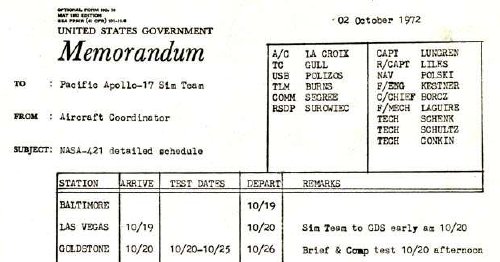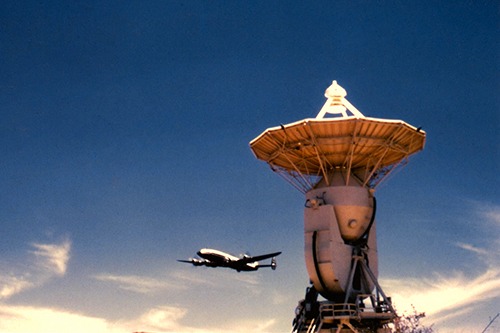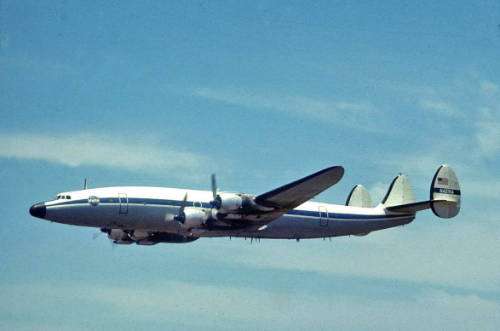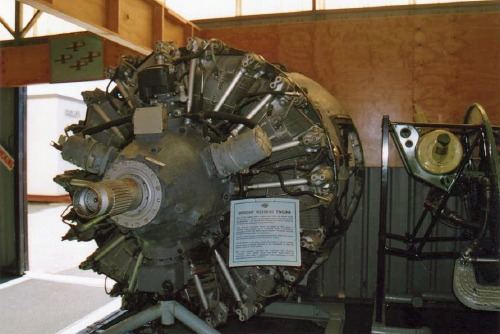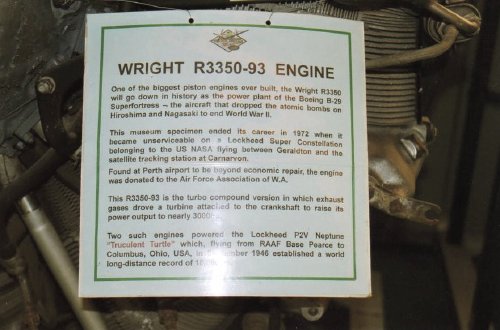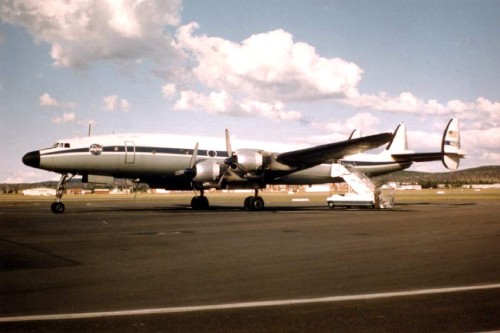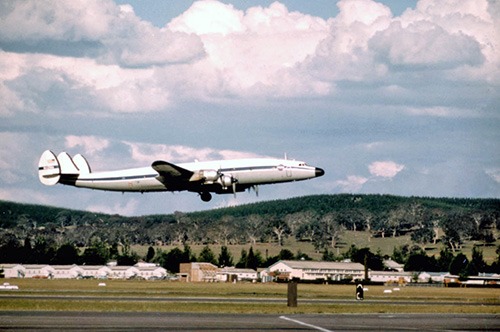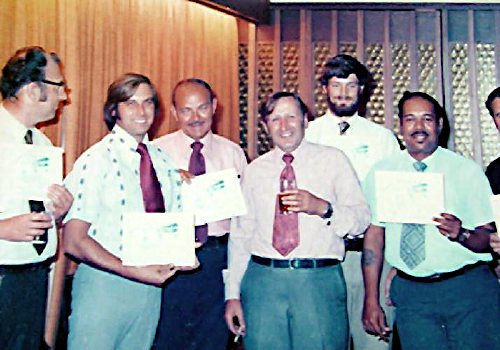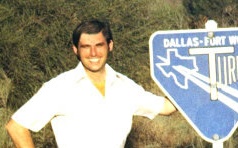 |
Bob Burns (pictured here at Carnarvon)
share theses memories of the last – and quite eventful
– Sims flight to Australia – prior to Apollo 17. |
Apollo 17 Simulations
Lockheed C-121G Super Constellation NASA 421,
Civil Registration No. N421NA
The scheduled arrival from Perth [After CRO Sims]
at Canberra was for 20 November 1972.
The Sim Team was to be off loaded, and the aircraft
proceed to Sydney, where it would base for the HSK simulations. Sim dates
were scheduled for 21 – 24 November. A 200-hour Aircraft Inspection was
scheduled at Sydney for 25–30 November, with a departure planned for
1 December 1972. [Apollo 17 Launch date: 7 December 1972]
|
|
|
The plan for the Pacific Apollo 17
Sim Team, October – December 1972.
Click for the full verson.
Courtesy Bob Burns. |
The crew of the last NASA 421 flight to
Australia
| GROUND SIMULATION
TEAM |
AIRCRAFT FLIGHT
CREW
and ELECTRONIC TECHS |
| Evan Gull
– Team Lead –NASA |
Capt. Charlie
Lungren – Pilot in Cmd. – BFEC |
| Bob Burns
– Telemetry – NASA |
Capt. Bob Liles*
– Co-Pilot – BFEC |
| Nick Polizos
– USB – NASA [Returned to Greece] |
Art “The
Prince” Kestner – Flight Engineer – BFEC |
| Calvin Segree*
– Comm – NASA |
Mike Polski*
– Navigator – BFEC |
| Dan Surowiec*
– RSDP – BFEC |
Hank “Mother”
Borcz* – Crew Chief – BFEC |
| [Dan substituted
for a NASA RSDP type who could
not make this trip.] |
Terry Laguire
– Flight Mechanic – BFEC |
| |
Dick LaCroix
– Aircraft Coordinator – NASA |
| |
Harry Schenk
– Lead Tech – BFEC |
| |
Bob Schultz*
– Telemetry Tech – BFEC |
| |
Jim Conkin*
– Command Tech – BFEC |
| [BFEC – Bendix
Field Engineering Corp.] |
* = now deceased |
|
To say this part of the trip was uneventful would be a fantasy.
While we were still in Guam, we received a teletype
from Goddard advising that the Instrumented Aircraft would be terminated upon
our return to the States.
To say this cast a somber mood upon the entire
crew would be a huge understatement. We got all the troops together and discussed
the situation, and basically said, “We’re professionals, so lets
suck it up, and continue on in the best tradition of the Sim Team and Air
Crew members”. Everyone then proceeded to the Base Exchanges at the Navy
and Air Force Base and proceeded to buy up enough stereo systems, cameras,
TV sets, etc.... to fill up any empty cargo space on NASA 421.
Credit card and check book balances took a mighty
hit that day, and the Guam Exchanges suffered a large depletion of their stock.
I can still recall the look on the face of the Customs Inspector at Darwin
as he came on board. We probably looked like a flying electronics store, with
boxes of speakers, stereos, TVs, etc... stacked all over the place, plus he
hadn’t yet seen what was in the cargo hold.
They wanted us to leave it all in Darwin until
we left Australia, but we finally convinced them that wasn’t too practical
since we would be departing via Sydney. They did insist that we unload everything
and have it logged in to insure that it all left Australia, and that we would
not be selling it. The Darwin folks were so nice, they said don’t worry,
they would unload everything, take it inside, then put it all back on the
aircraft... which they did.
Then they presented us with a bill for $400 Aust.
for that ‘nice’ service. Nice Guys!!
Well, we finally continued on to Perth, where
the Sim Team proceeded on to Canarvon on MMA, which we affectionately called
“Mickey Mouse Airlines”, and the Aircraft folks set up shop to operate
from Perth. The Carnarvon sims went well, and to the best of my knowledge
finished on schedule.
|
|
|
NASA 421 making a low pass over the
Carnarvon Station at the end of the Apollo 17 Sims, November 1972.
Photo: Stan Parkes, AWA accountant at Carnarvon, via Trevor Mosel. |
|
NASA 421 making a low pass over the
Carnarvon Station at the end of the Apollo 17 sims, November 1972.
Photo: Bob Burns. |
Unknown to the Sim Team, minutes after we shut down communications with NASA
421, the number 1 engine gave up the ghost and was feathered and shutdown
for the 600-mile trip to Perth.
When we flew back with MMA and taxied past NASA
421 and saw the feathered engine, we knew things were not going well. When
we checked with the flight crew, we got the bad news that we needed another
engine. The wheels were already in motion to have another engine flown in
from the States. I was tasked with flying ahead to Sydney, via commercial
airlines, and attempt to coordinate getting the new engine from Sydney to
Perth, using a charter airline flight. With all the people in the loop, things
got to be very chaotic.
Anyway, to make a long story short, the engine
did get to Perth, and changed out.
Now for the funny part. Since we were getting
rid of the Connies when we returned, we had no use for the bad engine, and
offered to a Technical School of some sort in Perth to use for training purposes.
Well, according to Australian law, it seems that we had to pay for the value
of the engine, which was still valued at $100,000.00 US, even though we were
giving it as a gift. At this point, the big brass got into the act and the
US Ambassador contacted some folks in Canberra, and Parliament passed some
sort of amendment to allow the engine to stay.
As a side note, I spoke to a Qantas Captain at
Oshkosh recently who is one of the pilots for the Connie that was brought
back to Australia in recent years. He informed me that they acquired our old
engine and did a complete rebuild as a spare for their bird. Unfortunately,
the paper trail is incomplete, and your Aviation folks will not approve its
use again.
|
And here is the engine!
It’s now on display at The Royal Australian Air Force Association Aviation Heritage Museum of Western Australia, at Bullcreek in Perth.
Photo: Trevor Mosel. |
|
This text tells the story of the engine.
Photo: Trevor Mosel. |
I digress. Anyhow, the engine change took place,
with the help of the Electronic Techs, and NASA 421 headed on to Canberra
with the rest of the Sim Team. I don’t have the exact date yet when it
arrived, but I’m sure we did not make the schedule date.
|
|
|
NASA 421 at Canberra, when the Sim
team was dropped off.
Photo: Bob Burns. |
|
|
NASA 421 at Canberra,
starting its engines.
Photo: Bob Burns. |
|
|
|
NASA 421 leaving
Canberra for Sydney where it would base for the Apollo 17 simulations.
Photo: Bob Burns. |
|
|
|
Most
of the Apollo 17 Sim team.
From left: Dan Surowiec (Bendix computer observer), Bob Burns,
Dick La Croix, Don Gray (HSK Station Director), Evan
Gull, Cal Segree and Nick ‘The Greek’ Polizos
(just visible).
Photo:
Robert ‘Hardy’ Dey. |
|
Bob Burns from the Sim Team took this photo
at Honeysuckle Creek in April 1972. |
I do know that we got back to the States just
before the launch, and I caught a flight down to Orlando, found a place to
stay, and made it over to Kennedy for the launch. It was my first Saturn V
launch, plus it was the first night launch. I remember the countdown did not
go too smoothly, with a lot of unscheduled holds.
I was watching from a site near the VAB [3-miles]
and was thinking that I would really like to be closer. The decision was finally
made to continue the launch, I seem to recall it was around 2 am in the morning,
and when the engines lit and it lifted off the pad it was like daylight. I
was still wishing I was closer, when the sound waves reached us, and the ground
was beginning to shake, and I started thinking that maybe I wouldn’t
like to be any closer...... it was AWESOME!!!!! It was one of those moments
that becomes a permanent place in the memory bank. I had no idea that you
could see the staging so clear with just the naked eye. I guess I had seen
so many TV shots, that I figured you had to have a powerful scope to see that
kind of detail. I watched it all the way down range until Bermuda AOS.
It was the first time that I witnessed an Apollo
launch, and of course it was the last moon mission. I did see another Saturn
V launch, when the Skylab was launched, and even though it was a day event,
it was still a spectacular sight. The Saturn V’s were real rockets.
I have seen a lot of Space Shuttle launches, and
they are great in their own way, but there is nothing that approaches the
Apollo Saturn Vs.

